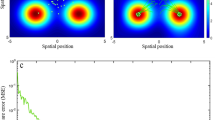Abstract
This paper investigates the control of multi-agent systems inspired by chemotaxis of microorganisms. Chemotaxis is a biological phenomenon wherein organisms in an environment are attracted to food but move away from toxins. The problem addressed here is a formation control problem, i.e., a design problem of distributed controllers wherein the relative positions of agents become the desired positions with the progression of time. To solve this problem, we introduce a performance index that quantifies the achieved degree of a desired formation, and decompose it into local indices that can be embedded in the distributed controllers. Based on this, we propose formation controllers inspired by chemotaxis of Escherichia coli (E. coli), where each agent moves with the aim of increasing the corresponding local performance index using the chemotaxis controller of E. coli. In addition, to improve the accuracy of the resulting formation, we present Paramecium caudatum (P. caudatum)-type formation controllers by replacing the chemotaxis controller of E. coli used above with that of P. caudatum. The effectiveness is demonstrated by a comparison with the E. coli-type formation controllers via numerical simulation. This result implies that various chemotaxis controllers can be used in our method and the performance of the resulting controllers can be improved by choosing an appropriate chemotaxis controller.















Similar content being viewed by others
Explore related subjects
Discover the latest articles, news and stories from top researchers in related subjects.References
Adler, J.: Chemotaxis in bacteria. Science 153(3737), 708–716 (1966)
Almagor, M., Ron, A., Bar-Tana, J.: Chemotaxis in Tetrahymena thermophila. Cell Motil. 1(2), 261–268 (1981)
Azuma, S., Owaki, K., Shinohara, N., Sugie, T.: Performance analysis of chemotaxis controllers: Which has better chemotaxis controller, Escherichia coli or Paramecium caudatum? IEEE/ACM Trans. Comput. Biol. Bioinf. 13(4), 730–741 (2016)
Bai, L., Eyiyurekli, M., Breen, D.E.: An emergent system for self-aligning and self-organizing shape primitives. In: Proceedings of the Second IEEE International Conference on Self-Adaptive and Self-Organizing Systems, pp. 445–454 (2008)
Bai, L., Eyiyurekli, M., Lelkes, P.I., Breen, D.E.: Self-organized sorting of heterotypic agents via a chemotaxis paradigm. Sci. Comput. Program. 78(5), 594–611 (2013)
Berg, H.C., Brown, D.A.: Chemotaxis in Escherichia coli analysed by three-dimensional tracking. Nature 239(5374), 500–504 (1972)
Dhariwal, A., Sukhatme, G., Requicha, A.A.G.: Bacterium-inspired robots for environmental monitoring. In: Proceedings of the 2004 IEEE International Conference on Robotics and Automation, vol. 2, pp. 1436–1443 (2004)
Eyiyurekli, M., Bai, L., Lelkes, P.I., Breen, D.E.: Chemotaxis-based sorting of self-organizing heterotypic agents. In: Proceedings of the 2010 ACM Symposium on Applied Computing, pp. 1315–1322 (2010)
Fatès, N., Vlassopoulos, N.: A robust aggregation method for quasi-blind robots in an active environment. In: Proceedings of the 2011 International Conference on Swarm Intelligence, pp. 1–10 (2011)
Grimes, S., Bai, L., McDonald, A.W.E., Breen, D.E.: Directing chemotaxis-based spatial self-organisation via biased, random initial conditions. Int. J. Parallel Emergent Distrib. Syst. 34(4), 380–399 (2019)
Hellung-Larsen, P., Leick, V., Tommerup, N.: Chemoattraction in Tetrahymena: on the role of chemokinesis. Biol. Bull. 170(3), 357–367 (1986)
Izumi, S., Azuma, S., Sugie, T.: Multi-robot control inspired by bacterial chemotaxis: coverage and rendezvous via networking of chemotaxis controllers. IEEE Trans. Robot. (submitted)
Izumi, S., Azuma, S., Sugie, T.: Coverage control inspired by bacterial chemotaxis. In: Proceedings of the 33rd IEEE Symposium on Reliable Distributed Systems, pp. 34–39 (2014)
Lytridis, C., Kadar, E.E., Virk, G.S.: A systematic approach to the problem of odour source localisation. Auton. Robots 20(3), 261–276 (2006)
Lytridis, C., Virk, G.S., Rebour, Y., Kadar, E.E.: Odor-based navigational strategies for mobile agents. Adapt. Behav. 9(3–4), 171–187 (2001)
Marques, L., Nunes, U., de Almeida, A.T.: Olfaction-based mobile robot navigation. Thin Solid Films 418(1), 51–58 (2002)
Mesbahi, M., Egerstedt, M.: Graph Theoretic Methods in Multiagent Networks. Princeton University Press, Princeton (2010)
Murata, S., Konagaya, A., Kobayashi, S., Saito, H., Hagiya, M.: Molecular robotics: a new paradigm for artifacts. New Generat. Comput. 31(1), 27–45 (2013)
Nurzaman, S.G., Matsumoto, Y., Nakamura, Y., Koizumi, S., Ishiguro, H.: ‘Yuragi’-based adaptive mobile robot search with and without gradient sensing: from bacterial chemotaxis to a Levy walk. Adv. Robot. 25(16), 2019–2037 (2011)
Oh, H., Shirazi, A.R., Sun, C., Jin, Y.: Bio-inspired self-organising multi-robot pattern formation: a review. Robot. Auton. Syst. 91, 83–100 (2017)
Oyekan, J., Gu, D., Hu, H.: Visual imaging of invisible hazardous substances using bacterial inspiration. IEEE Trans. Syst. Man Cybernet. Syst. 43(5), 1105–1115 (2013)
Oyekan, J., Hu, H.: Bacteria controller implementation on a physical platform for pollution monitoring. In: Proceedings of the 2010 IEEE International Conference on Robotics and Automation, pp. 3781–3786 (2010)
Oyekan, J., Hu, H., Gu, D.: A novel bio-inspired distributed coverage controller for pollution monitoring. In: Proceedings of the 2011 IEEE International Conference on Mechatronics and Automation, pp. 1651–1656 (2011)
Pugh, J., Martinoli, A.: Inspiring and modeling multi-robot search with particle swarm optimization. In: Proceedings of the 2007 IEEE Swarm Intelligence Symposium, pp. 332–339 (2007)
Russell, R.A., Bab-Hadiashar, A., Shepherd, R.L., Wallace, G.G.: A comparison of reactive robot chemotaxis algorithms. Robot. Auton. Syst. 45(2), 83–97 (2003)
Tso, W., Adler, J.: Negative chemotaxis in Escherichia coli. J. Bacteriol. 118(2), 560–576 (1974)
Van Houten, J.: Two mechanisms of chemotaxis in Paramecium. J. Comp. Physiol. 127(2), 167–174 (1978)
Van Houten, J., Hansma, H., Kung, C.: Two quantitative assays for chemotaxis in Paramecium. J. Comp. Physiol. 104(2), 211–223 (1975)
Yang, B., Ding, Y., Jin, Y., Hao, K.: Self-organized swarm robot for target search and trapping inspired by bacterial chemotaxis. Robot. Auton. Syst. 72, 83–92 (2015)
Yang, J., Wang, X., Bauer, P.: V-shaped formation control for robotic swarms constrained by field of view. Appl. Sci. 8(11), 2120 (2018)
Author information
Authors and Affiliations
Corresponding author
Additional information
Publisher's Note
Springer Nature remains neutral with regard to jurisdictional claims in published maps and institutional affiliations.
This work was supported by JSPS KAKENHI Grant numbers 17H03280 and 19K15016.
About this article
Cite this article
Izumi, S., Azuma, Si. Chemotaxis-Inspired Control for Multi-Agent Coordination: Formation Control by Two Types of Chemotaxis Controllers. New Gener. Comput. 38, 303–324 (2020). https://doi.org/10.1007/s00354-020-00093-0
Received:
Accepted:
Published:
Issue Date:
DOI: https://doi.org/10.1007/s00354-020-00093-0




